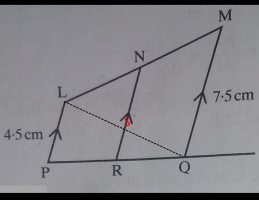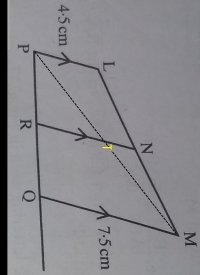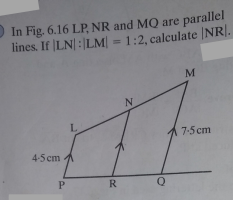Let me try to be as you are already helping me to be. Thank you.
Try drawing in some other line to make triangles, and see what you can do then.
You might draw segment LQ,
Just like I was saying before, since |LN|:|LM| = 1:2, it follows that |LN|=|NM| and |PR| =|RQ| according to the theorem that states that if three or more parallel lines cut off equal intercept on a transversal, then they cut off equal intercept on any other transversal.
From the picture, I can see that |LP| = 4.5 and |MQ| = 7.5
I am using ΔQLM
Here is the segment LQ.
.

Now I am using the idea of similar triangles.
∣LM∣∣LN∣=∣LM∣∣LN∣=∣QM∣∣SN∣=21∴ ∣QM∣∣SN∣=21 → 7.5∣SN∣=212∣SN∣=7.5 then SN=7.5÷2=3.75 cmBut I was asked to calculate NR.
|NR| = |RS| + |NS|
From ΔLQP
Since
∣LQ∣∣LS∣=21 (sharing adjacent sides)andΔSQR ΔLQP it follows that∣QL∣∣QS∣=∣QP∣∣QR∣=21=∣LP∣∣SR∣→ 21=4.5∣SR∣ → 4.5=2∣SR∣ → ∣SR∣=4.5÷2=2.25 cm∴ |SR|=2.25 cmAs |NR| = |RS|+|NS| = 3.75+2.75 = 6 cm

If decides to work from ΔMLP,
As |LN|:|LM| =1:2, then |MN|:|NL| = 1:1 so also |MN|:|ML| = 1:2 , according the theorem I had stated earlier.... still using the idea of ~ Δ
ML∣MN∣=21=∣MP∣∣MT∣=∣LP∣∣NT∣=21→ ∣LP∣∣NT∣=21 → 4.5∣NT∣=21 → 2∣NT∣=4.5∴ ∣NT∣=4.5÷2=2.25 cmAs |NR| = |NT| + |TR|
From ΔPMQ
If
∣MP∣∣MT∣=21 , it follows that ∣PT∣:∣TM∣=∣RQ∣∣PR∣=1:1then ∣RQ∣∣PR∣=∣TM∣∣PT∣=21=∣QM∣∣RT∣ → ∣QM∣∣RT∣=21∣7.5∣∣RT∣=21 → 2∣RT∣=7.5∣RT∣=3.75 cm∣NR∣=2.25 cm+(3.75 cm)=6 cm
or a line through L parallel to PQ
View attachment 1708341924605.jpeg
Let me try using the fact that |LU| is parallel to |PQ|. The only thing I can deduce from here is that suppose I am applying the idea of similar Δs.
That is |LN|:|LM|=1:2
∴ ∣LM∣∣LN∣=∣LU∣∣LV∣=21So how do I get the value of |VN| or is there a better way I can handle it?
Ah, yes -- it's a theorem about midlines of trapezoids.)
What about it? Maybe I will google it later.



